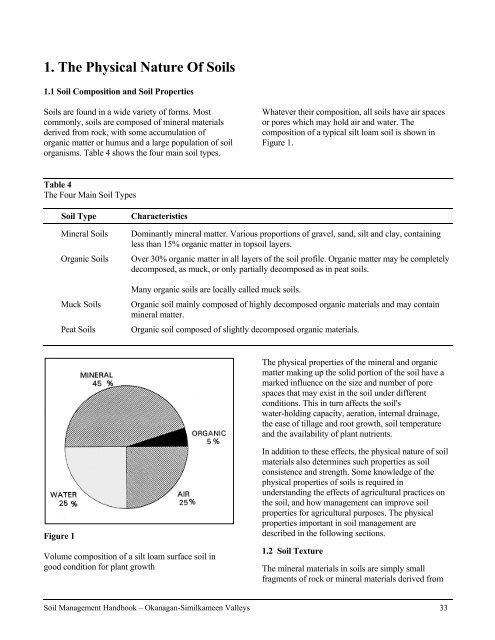Soil Management Handbook - Ministry of Agriculture and Lands
Soil Management Handbook - Ministry of Agriculture and Lands
Soil Management Handbook - Ministry of Agriculture and Lands
Create successful ePaper yourself
Turn your PDF publications into a flip-book with our unique Google optimized e-Paper software.
1. The Physical Nature Of <strong>Soil</strong>s<br />
1.1 <strong>Soil</strong> Composition <strong>and</strong> <strong>Soil</strong> Properties<br />
<strong>Soil</strong>s are found in a wide variety <strong>of</strong> forms. Most<br />
commonly, soils are composed <strong>of</strong> mineral materials<br />
derived from rock, with some accumulation <strong>of</strong><br />
organic matter or humus <strong>and</strong> a large population <strong>of</strong> soil<br />
organisms. Table 4 shows the four main soil types.<br />
Table 4<br />
The Four Main <strong>Soil</strong> Types<br />
Figure 1<br />
<strong>Soil</strong> Type Characteristics<br />
Whatever their composition, all soils have air spaces<br />
or pores which may hold air <strong>and</strong> water. The<br />
composition <strong>of</strong> a typical silt loam soil is shown in<br />
Figure 1.<br />
Mineral <strong>Soil</strong>s Dominantly mineral matter. Various proportions <strong>of</strong> gravel, s<strong>and</strong>, silt <strong>and</strong> clay, containing<br />
less than 15% organic matter in topsoil layers.<br />
Organic <strong>Soil</strong>s Over 30% organic matter in all layers <strong>of</strong> the soil pr<strong>of</strong>ile. Organic matter may be completely<br />
decomposed, as muck, or only partially decomposed as in peat soils.<br />
Many organic soils are locally called muck soils.<br />
Muck <strong>Soil</strong>s Organic soil mainly composed <strong>of</strong> highly decomposed organic materials <strong>and</strong> may contain<br />
mineral matter.<br />
Peat <strong>Soil</strong>s Organic soil composed <strong>of</strong> slightly decomposed organic materials.<br />
Volume composition <strong>of</strong> a silt loam surface soil in<br />
good condition for plant growth<br />
The physical properties <strong>of</strong> the mineral <strong>and</strong> organic<br />
matter making up the solid portion <strong>of</strong> the soil have a<br />
marked influence on the size <strong>and</strong> number <strong>of</strong> pore<br />
spaces that may exist in the soil under different<br />
conditions. This in turn affects the soil's<br />
water-holding capacity, aeration, internal drainage,<br />
the ease <strong>of</strong> tillage <strong>and</strong> root growth, soil temperature<br />
<strong>and</strong> the availability <strong>of</strong> plant nutrients.<br />
In addition to these effects, the physical nature <strong>of</strong> soil<br />
materials also determines such properties as soil<br />
consistence <strong>and</strong> strength. Some knowledge <strong>of</strong> the<br />
physical properties <strong>of</strong> soils is required in<br />
underst<strong>and</strong>ing the effects <strong>of</strong> agricultural practices on<br />
the soil, <strong>and</strong> how management can improve soil<br />
properties for agricultural purposes. The physical<br />
properties important in soil management are<br />
described in the following sections.<br />
1.2 <strong>Soil</strong> Texture<br />
The mineral materials in soils are simply small<br />
fragments <strong>of</strong> rock or mineral materials derived from<br />
<strong>Soil</strong> <strong>Management</strong> <strong>H<strong>and</strong>book</strong> – Okanagan-Similkameen Valleys 33
















